最新应用化学专业英语课文翻译
应用化学专业英语课文翻译(精选篇)
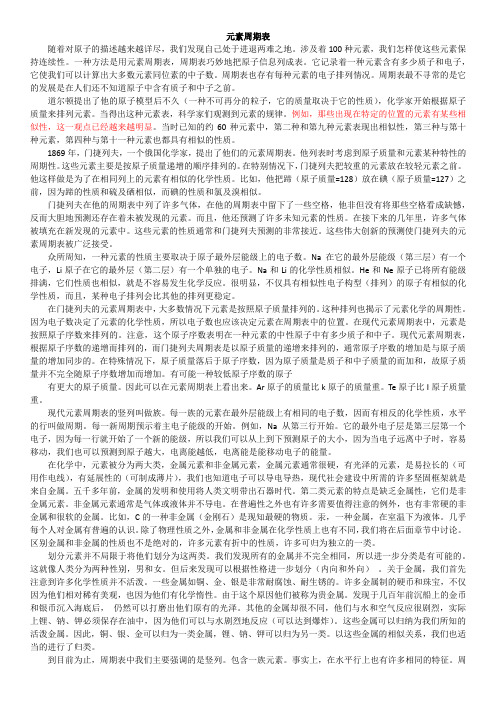
元素周期表随着对原子的描述越来越详尽,我们发现自己处于进退两难之地。
涉及着100种元素,我们怎样使这些元素保持连续性。
一种方法是用元素周期表,周期表巧妙地把原子信息列成表。
它记录着一种元素含有多少质子和电子,它使我们可以计算出大多数元素同位素的中子数。
周期表也存有每种元素的电子排列情况。
周期表最不寻常的是它的发展是在人们还不知道原子中含有质子和中子之前。
道尔顿提出了他的原子模型后不久(一种不可再分的粒子,它的质量取决于它的性质),化学家开始根据原子质量来排列元素。
当得出这种元素表,科学家们观测到元素的规律。
例如,那些出现在特定的位置的元素有某些相似性,这一观点已经越来越明显。
当时已知的约60种元素中,第二种和第九种元素表现出相似性,第三种与第十种元素,第四种与第十一种元素也都具有相似的性质。
1869年,门捷列夫,一个俄国化学家,提出了他们的元素周期表。
他列表时考虑到原子质量和元素某种特性的周期性。
这些元素主要是按原子质量递增的顺序排列的。
在特别情况下,门捷列夫把较重的元素放在较轻元素之前。
他这样做是为了在相同列上的元素有相似的化学性质。
比如,他把蹄(原子质量=128)放在碘(原子质量=127)之前,因为蹄的性质和硫及硒相似,而碘的性质和氯及溴相似。
门捷列夫在他的周期表中列了许多气体,在他的周期表中留下了一些空格,他非但没有将那些空格看成缺憾,反而大胆地预测还存在着未被发现的元素。
而且,他还预测了许多未知元素的性质。
在接下来的几年里,许多气体被填充在新发现的元素中。
这些元素的性质通常和门捷列夫预测的非常接近。
这些伟大创新的预测使门捷列夫的元素周期表被广泛接受。
众所周知,一种元素的性质主要取决于原子最外层能级上的电子数。
Na在它的最外层能级(第三层)有一个电子,Li原子在它的最外层(第二层)有一个单独的电子。
Na和Li的化学性质相似。
He和Ne原子已将所有能级排满,它们性质也相似,就是不容易发生化学反应。
应用化学专业英语翻译
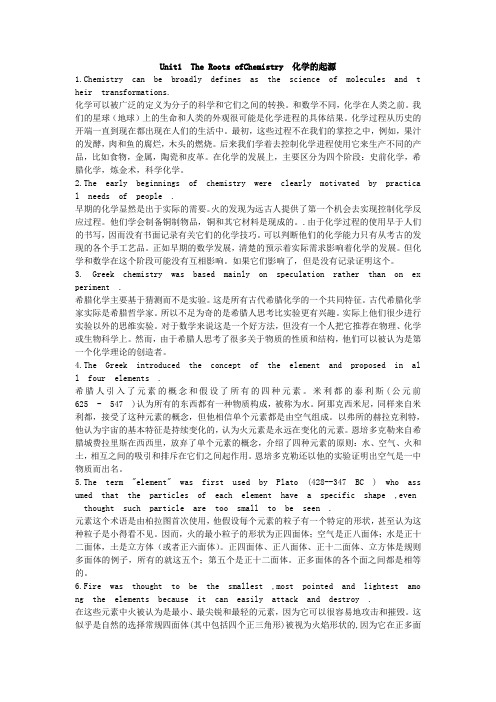
Unit1 The Roots ofChemistry 化学的起源1.Chemistry can be broadly defines as the science of molecules and their transf ormations.化学可以被广泛的定义为分子的科学和它们之间的转换。
和数学不同,化学在人类之前。
我们的星球(地球)上的生命和人类的外观很可能是化学进程的具体结果。
化学过程从历史的开端一直到现在都出现在人们的生活中。
最初,这些过程不在我们的掌控之中,例如,果汁的发酵,肉和鱼的腐烂,木头的燃烧。
后来我们学着去控制化学进程使用它来生产不同的产品,比如食物,金属,陶瓷和皮革。
在化学的发展上,主要区分为四个阶段:史前化学,希腊化学,炼金术,科学化学。
2.The early beginnings of chemistry were clearly motivated by practical needs of people .早期的化学显然是出于实际的需要。
火的发现为远古人提供了第一个机会去实现控制化学反应过程。
他们学会制备铜制物品,铜和其它材料是现成的。
.由于化学过程的使用早于人们的书写,因而没有书面记录有关它们的化学技巧。
可以判断他们的化学能力只有从考古的发现的各个手工艺品。
正如早期的数学发展,清楚的预示着实际需求影响着化学的发展。
但化学和数学在这个阶段可能没有互相影响。
如果它们影响了,但是没有记录证明这个。
3. Greek chemistry was based mainly on speculation rather than on experiment . 希腊化学主要基于猜测而不是实验。
这是所有古代希腊化学的一个共同特征。
古代希腊化学家实际是希腊哲学家。
所以不足为奇的是希腊人思考比实验更有兴趣。
实际上他们很少进行实验以外的思维实验。
对于数学来说这是一个好方法,但没有一个人把它推荐在物理、化学或生物科学上。
应用化学专业英语翻译完整篇

应用化学专业英语翻译完整篇应用化学专业英语翻译完整篇1 Unit5元素周期表As our picture of the atom becomes more detailed 随着我们对原子的描述越来越详尽,我们发现我们陷入了进退两难之境。
有超过100多中元素要处理,我们怎么能记的住所有的信息?有一种方法就是使用元素周期表。
这个周期表包含元素的所有信息。
它记录了元素中所含的质子数和电子数,它能让我们算出大多数元素的同位素的中子数。
它甚至有各个元素原子的电子怎么排列。
最神奇的是,周期表是在人们不知道原子中存在质子、中子和电子的情况下发明的。
Not long after Dalton presented his model for atom( ) 在道尔顿提出他的原子模型(原子是是一个不可分割的粒子,其质量决定了它的身份)不久,化学家门开始根据原子的质量将原子列表。
在制定像这些元素表时候,他们观察到在元素中的格局分布。
例如,人们可以清楚的看到在具体间隔的元素有着相似的性质。
在当时知道的大约60种元素中,第二个和第九个表现出相似的性质,第三个和第十个,第四个和第十一个等都具有相似的性质。
In 1869,Dmitri Ivanovich Mendeleev,a Russian chemist, 在1869年,Dmitri Ivanovich Mendeleev ,一个俄罗斯的化学家,发表了他的元素周期表。
Mendeleev通过考虑原子重量和元素的某些特性的周期性准备了他的周期表。
这些元素的排列顺序先是按原子质量的增加,,一些情况中, Mendeleev把稍微重写的元素放在轻的那个前面.他这样做只是为了同一列中的元素能具有相似的性质.例如,他把碲(原子质量为128)防在碘(原子质量为127)前面因为碲性质上和硫磺和硒相似, 而碘和氯和溴相似.Mendeleev left a number of gaps in his table.Instead of Mendeleev在他的周期表中留下了一些空白。
最新应用化学专业英语第二版万有志主编版(课后答案和课文翻译)资料
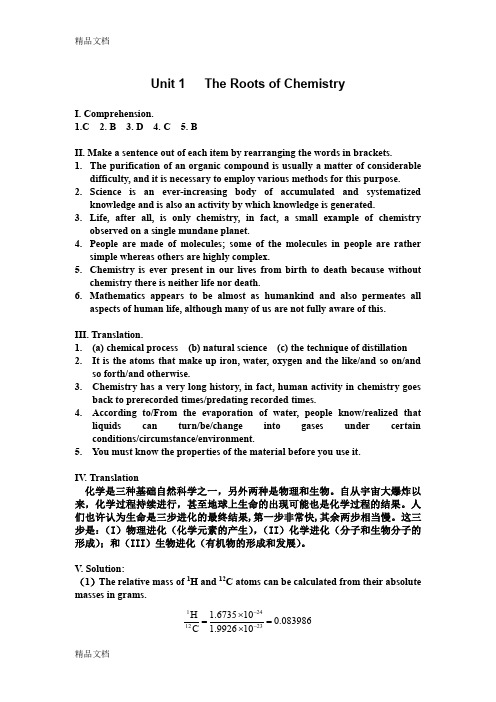
Unit 1 The Roots of ChemistryI. Comprehension.1.C2. B3. D4. C5. BII. Make a sentence out of each item by rearranging the words in brackets.1. The purification of an organic compound is usually a matter of considerable difficulty, and it is necessary to employ various methods for this purpose.2. Science is an ever-increasing body of accumulated and systematized knowledge and is also an activity by which knowledge is generated.3. Life, after all, is only chemistry, in fact, a small example of chemistry observed on a single mundane planet.4. People are made of molecules; some of the molecules in people are rather simple whereas others are highly complex.5. Chemistry is ever present in our lives from birth to death because without chemistry there is neither life nor death.6. Mathematics appears to be almost as humankind and also permeates all aspects of human life, although many of us are not fully aware of this.III. Translation.1. (a) chemical process (b) natural science (c) the technique of distillation2. It is the atoms that make up iron, water, oxygen and the like/and so on/andso forth/and otherwise.3. Chemistry has a very long history, in fact, human activity in chemistry goesback to prerecorded times/predating recorded times.4. According to/From the evaporation of water, people know/realized thatliquids can turn/be/change into gases under certain conditions/circumstance/environment.5. You must know the properties of the material before you use it.IV . Translation化学是三种基础自然科学之一,另外两种是物理和生物。
最新应用化学专业英语12单元翻译

Perhaps the most function definition of analytical chemistry is that it is "the qualitative and quantitative characterization of matter "也许对分析化学最实用的定义是:对物质进行定性和定量的表征。
描述这个词被广泛的使用。
它可能意味着在回答诸如“在洗发香波中是否如标签所示有维生素E”“这是一个白色阿司匹林片?”或“这块金属是铁或镍”等问题时,对样本中的化合物或元素进行鉴定。
这种类型的表征,要告诉我们什么是目前被称为的定性分析。
定性分析是鉴定一个或多个化学物质存在于一个材料中。
描述也可能意味着测定有多少种化合物或元素存在于一个样品中,回答“水杨酸在这个阿司匹林片中含量多少”或“这块钢中含有多少镍”等这些问题。
一种物质在一个样品中含量多少的这种测定被称为定量分析。
定量分析是测定某种化学物质在某个样品中的确切数量。
化学物质可能是某些元素、化合物或离子。
该药物可能有机和无机两种。
特性描述可能涉及到全分析,如构成一块钢的元素,或者表面分析,像鉴定绝大多数暴露在空气和水中的金属表面形成的氧化层的成分和厚度。
一个材料的特性描述可能超越化学分析所包括结构材料的确定,某个材料的物理性质的测量,以及物理化学参数的测量例如反应动力学。
这些测量的实例有:聚合物的结晶度(与非晶态相比)?物质失去结晶水的温度?“A牌”抗酸剂中和胃酸所需的时间?农药在阳光下的降解速度?这些不同的应用使分析化学成为广泛的学科之一在所有的科学学科中。
分析化学对于我们了解生物化学是至关重要的。
药物化学、地球化学、环境科学、大气化学,材料学中的反应像聚合物、金属合金和陶瓷技术以及许多其他科学领域。
For many years ,analytical chemistry relied on chemical reactions to identify and determine the components present in a sample.多年来,分析化学依赖化学反应,以确定出现在一个样本中的组分。
应用化学专业英语 Lesson 28 翻译

Lesson 28 A Experiment Ease: Synthesis ofSalicylic AcidFrom Oil of Wintergreen (MethylSalicylate)overviewMethyl salicylate (水杨酸酯) (oil of wintergreen) and salicylic acid (水杨酸) are naturally occurring compounds with medicinal uses. You will try to prepare salicylic acid by boiling methyl salicylate with aqueous sodium hydroxide(lye 碱液). You will also try to purify your product by recrystallization (再结晶) and characterize it by measuring its melting temperature.Time require:2 laboratory sessions.Background Methyl salicylate and salicylic acid are naturally occurring compounds with medicinal uses. The procedure used here to convert methyl salicylate into salicylic acid is called saponification (皂化)。
It is chemically related to the process used to convert natural fats into soap. Salicylic acid and aspirin Many plants produce salicylic acid naturally. Among these, willow trees (柳树) have been recognized since antiquity as a potent (有效) source of medicine. Hippocrates (一个希腊的名医) encouraged the pregnant women of ancient Greece to chew willow leaves and drink willow tea to alleviate (减轻) labor and birth pains. Chinese, Native Americans, and others also used willow. Salicylic acid is found mainly in the willo w’s leaves and bark (树皮).The pure acid possesses several useful medicinal properties. It is an antipyretic (a fever reducer), an analgesic (a pain reducer), and an anti-inflammatory (a swelling reducer). Unfortunately, pure salicylic acid and even the concoctions (混合物) derived from willow, make for an extremely unpleasant medicine. The salicylic acid molecule contains two acidic functional groups, the phenol group (PhOH) and the carboxylic acid group (-COOH). These groups make salicylic acid an irritating (刺激性的) substance that burns the sensitive linings of the mouth, throat, esophagus (食道), and stomach. [Interestingly, salicylic acid’s ability to burn living tissue28课 一个实验案例:从冬青油(水杨酸酯)中合成水杨酸概述水杨酸酯(冬青油)和水杨酸是常用于药物合成的天然物质。
应化专业专业英语文献原文及翻译

化学文献及翻译10化二郑博201006010123Operation of plate rectification tower Abstract:The influencing factors,abnoimal phenomenon and rectification process were analyzed to direct actual operationKey words: rectification tower,recification,reboiler,operationDistillation column is a multi-stage partial vaporization and partial condensation according to the different components in the mixture volatility in each floor tower board to achieve the separation of a mixture of various components of the tower gas-liquid contact device, also known as distillation. A plate column and packed column types. According to mode of operation are divided into continuous distillation and batch distillation. Steam from the bottom of the column entry, and the decline in liquid countercurrent contact with the two in contact, the drop in the volatile liquid (low boiling point) components is continuously transferred to the steam. The difficulty of steam volatile (high boiling) component continued to decline in the transfer of liquid, steam the closer the top of the tower, the higher the concentration of its volatile components, while the decline in the closer tower bottom liquid, its hard to be more volatile components rich set, to achieve component separation. Steam rising from the top of the tower into the condenser, the liquid part of the condensate as reflux liquid to return into the distillation tower, the rest is removed as distillate. Tower bottom outflow of liquid, some of which into the reboiler, thermal evaporation, the steam back to tower, and the other part of the liquid as residua release.Compared with other chemical unit operations,distillation unit,although relatively simple,single production run that often appear in a variety of problems affecting the operation of the distillation unit,leading to tower top orbottom of product failure,severe constraints of production equipmentthe operation resulting in product loss.1.Regular changes in process conditions of distillation column 1.1 Reboiler temperatureUnder the same operating pressure,raising the temperature of the reboiler,the volatile components in the tower liquid to reduce,at the same time,the rising vapor velocity increases,and help to improve the efficiency of mass transfer.If products fromthe top of the tower,the tower reactor discharge of difficult volatiles volatile components to reduce and reduce losses.If the tower reactor effluents for the product,it can improve product quality tower discharge of volatile components entrained difficult nolatile components increased,thereby increasing the losses.In balanced operation,the reactor temperature is suddenly increased,and it too late to adjust the pressure and temperature will inevitably lead to the reboiler fluid is steam-air, the pressure increased.At this time,the tower gas,liquid composition changes,the restructuring were likely to be steamed to the top of the tower,so that the failure of top product.1.2 Operating pressureIn the case of certain operating temperature,increasing the operating pressure can increase the productive capacity of the tower,so that stable operation,but the content of volatile group in the tower reactor products.In distillation,often provides for the adjustment range of the operating pressure.When the fallout of the operating pressure by extmrnal factors,were destroyed,the normal operation of the tower will be completely destroyed.1.3 Feeding temperature1.3.1Condensate feed,the feed temperature is lower than the temperature of the feeding board,and added if all the material into the stripper segment,stripping segment load increases,the reboiler consumption increase in the amount of steam,and the top of the tower is difficult volatile group were lower.1.3.2Saturated steam feed,the feed material temperature is higher than the temperature of feed board,all the material of the feed into the rectifying section and stripping section of the load reduction,and increased load of the rectifying section,make the top product quality reduce.1.4 Feeding quantity and composition changesChanges in the feedstock of a direct impact on the change of the amount of steam,the latter increase will produce entrained,even flooding.The feedstock is too low,the operation is not good to maintain the balance of the tower,the steam veloc ity decreases,the plate is prone to leakage,the rectification efficiency is low.Inthe low-load operation,may be appropriate to increase the reflux ratio,the tower operating in a load lower limit above normal and stable operation in order to maintain the tower.Feeding component of the changes directly affect the product quality.Increased restructuring concentration increase in the rectifying section load separation is notgood,the results of restructuring were brought to the top of tower,causing the top of the tower of inferior quality.Product from the reboiler,the top of the tower losses increase.If the concentration of the volatile group in the feeding group were increased,and the stripping section of the load increases,may be poor due to the separation caused by the tower reactor products of inferior quality,which entrained volatile components increased.Feeding restructuring concentration increased,the feeding mouth move down and vice versa,then move up.The same time,operating temperature,back flow and operating pressure must be adjusted accordingly in order to ensure the stability of the distillation operation.Distillation,increasing the reflux ratio,can improve the quality of the product,but the reflux ratio is too large,the inner loop of the tower increased,increasing energy consumption.Reduction of the reflux ratio,the tower gas-liquid contact is not good,the balance to damaged and therefore the mass transfer efficiency decreased.The same time,the operating pressure drop,difficult volatile components easily brought to the top of the tower,resulting in a substandard product.2 Anomalies in the distillation column during operation2.1 Plate capacityRectifying section tray downcomer overflow liquid transportation,however,that the tower upper part of the beginning of flooding,a phenomenon known as downcomer obstruction or liquid flooding.Its causes is to block the liquid leaving the tower board level rise in the downcomer plate between mist entrained excessive leaving the tray efficiency to reduce entrainment of this phenomenon is known as the excessive fog or steam flooding,the reason is the relativein the gas while the tower board bubbling area is too small.2.2 Plate foulingSediment cumulative to the board of board of the tower is an important issue,trays of dirt will tower premature flooding will reduce the plate efficiency.Plate scaling phenomenon:(1)The reflux ratio is not high on liquid pan;(2)The pressure drop increase between the tray;(3)Increase the reflux ratio on the bottom of the column temperature,flow or reboiler load does not have any impact,if the reflux ratio to the heat balance and material balance of 20% to 30%,while the tower did not change significantly,then the tower must be completely full of liquid.The amount of returning tower direct stream gas pipeline through the top of the tower back to the reflux tank.2.3 Slug flows in the riserSlug flow in the riser is a distillation column running unstable,may be caused due to an unstable gas-liquid mixture flow in the vertical pipeline.Reflux tank is elevated at the of the condenser by the condenser discharge logistics is that part of the pipeline between the gas-liquid two-phase mixture,the condenser and reflux tank is called the riser.Generate a liquid column in the riser flow rate is too low will result in two-phase separation,the distillation column to produce a back pressure,this liquid column intermittently be introduced after the riser,back pressure will weaken,then the risergradually being filled with liquid,such slug flow will cause the tower pressureperiodic pulse of change.Abnormal factors cause distillation column plate was washed away,condenser corrosion,clogged caondenser,not condensable gas influence condenser.3.ReboilerReboiler in the distillation column occupies a very important position,it used to bebottom after the vaporization of the liquid part of the back to the distillation column,two phases of the tower gas-liquid contact and mass transfer to proceed.Which used the vertical thermal siphon reboiler,which is a vertical placement of the shell and tube heat exchanger.Partial vaporization of liquid in the bottom-up tube passes through the heat exchanger,heating the heat carrier in the shell.V ertical thermal siphon reboiler features:(1)cycle driving force:the density of the reactor liquid and the heat exchanger tube gas-liquid mixture;(2)compact,small footprint,high heat transfer coefficient;(3)of the shell can not be mechanically cleaned,not suitable for hightower reactor,heat transfer medium viscosity,or dirty;(4)provide the space and buffer zones of the gas-liquid separator.Factors that determine the distillation column capacity restricted,find the reboiler failure is the most laborious,the distillation column by steam reboiler.(1)gas-barrier drain valve failure;(2)steam condensate collected indoor pressure is too large;(3)the condensate liquid seal failure.Hydrophobic failure caused by hydrophobic failure factors:3.1 Thermosiphon rebiler failureReboiler liquid inlet pipe and outlet pipe cold liquid mixture exists between the density difference is the density difference driving the process of processing liquid flow through the reboiler.When tower humoral bit elevated to the reboiler back to the liquid nozzle height,siphon circulation will be impeded.The circulation rate reductionwill result in the reduction of heat transfer,thus the cover back to the fluid nozzle is clearly an important reason for fluctuations in the reboiler duties.3.2 Non-condensable gas in the water vaporSteam reboiler to run the process,water vapor may be non-condensable gases,or the reboiler leak,the hydrocarbon vapor or other non-condensable gas into the reboiler,the non-condensable gas into the reboiler pipingthereby reducing the heat transfer capacity of the reboiler with the distillation column within a circulating fluid,thus causing the reboiler heat transfer efficiency decreased.4 ConclusionIn view of these problems often appear in a production run affect the operation of the distillion unit,leading ton the top of the tower or the bottom of prod uct failure,seriously restricting the production device to run resulting in product loss.In order to avoid such things from bappening,the operator should do the following:4.1 storage and transportation of materialsPlate column distillation process must be set in place a number of different volume raw material storage tanks,pumps and all kinds of heat exchanger has been temporarily stored,transported and preheating(cooling)of materials used,in order to protect the device can be a continuous and stable operation.4.2 Necessary means of detectionIn order to facilitate the resolution of the problem in the operation shall be the appropriate place in the process to set the necessary instrumentation,as well as to obtain the pressure,temperature and other parameters.In addition,often set in a particular place manholes and hand holes,so that regular testing and maintenance.4.3 Adjustment deviceState parameters are not in the actual production value should be placed in the appropriate location of a certain number of the valve to be adjusted to achieve the production requirements,can be a double adjustment,that is both automatic and manual adjustment coexist,and at any timeswitch.。
应用化学专业英语第二版万有志主编版(课后答案和课文翻译)

应用化学专业英语第二版万有志主编版(课后答案和课文翻译)If the mass of a 12C atom is exactly 12 amu,then the mass of a 1H atom to five significant figures must be 1.0078 amu. 12 amu x 0.083986 = 1.0078 amu(2)First we calculate k and then use the first-order rate equation.[][]()()404340.6931.2110/5730log2.3031.000 1.2110/log0.477 2.3032.303log 2.09 6.11061001.2110/k yryrA ktA yrt t yr yr---==⨯=⨯===⨯=⨯The bone was tossed away (more precisely, the animal whose bone was died) about 6100 years ago, or about 4100 B.C. We can thus be sure that a village was in existence at that place at that time.Unit 7 The Nomenclature of Inorganic SubstancesI. Comprehension1.A2.B3.C4.C5.BII. Give the systematic name for the followingammonium ion ; copper(II) ion ; strontium ion; Ccopper(I) ion; iron(II) ion; zinc ion; hydrogen ion; lead((II) ion; aluminum;silver ion; magnesium ion; chromium(III) ion; Barium ; Manganese(II) ion; iron(III) ion; calcium ion; mercury(II) ion; chromium(II) ion; tin(II) ion.carbon monoxide; ditrogen trioxide; carbon dioxide; diphosphorus pentoxide; sulfur trioxide; dichlorine heptoxidearsenate ion; sulfite ion; hydride ion; arsenite ion; bromide ion; hydroxide ion; phosphate ion; chlorate ion; hypochlorite ion; phosphate ion; chloride ion; iodate ion; carbonate ion; chlorite ion; nitrate ion;chromate ion; cyanide ion; iodide ion;dichromate ion; fluoride ion; nitrate ion;oxide ion; hydrogen carbonate ion; nitrite ion;sulfide ion; hydrogen sulfate ion; perchlorate ion;sulfate ion; hydrogen sulfite ion; permanganate ion.III. Complete the table.Formula Old name SystematicnameFeO iron (II) oxide Fe2O3iron (III) oxide Sn(OH)2tin(II)hydroxideSn(OH)4tin(IV)hydroxideHg2SO4mercury (I)sulfateHgSO4mercury (II)sulfate NaCLO sodiumhypochloriteK2Cr2O7potassiumdichromateCu3(AsO4)2copper(II)arsenateCr(C 2H 3O 2)3 chromium(IV) acetateIV . Acid names may be obtained directly from its acid ion by changing the name of the acid ion (negative ion). Use the rule to give the name of the following acid. Formula of acid Old name Name of acid H 2CO 3 carbonic acid HClO 2 chlorous acid HClO 4 perchloric acid HCN hydrocyanic acid HBr hydrobromic acid H 4SiO 4 silicic acid H 3AsO 4 arsenic acid V . Complete the sentences with the proper form of the word given at the end of the sentence.1.is altered;2.To illustrate3.indicates4.should expect5.would cancel6. are pulled7.depend on8.are; referred9.formed 10.have discussed VI. Translation1. Matter can neither be created nor be destroyed/eliminated.2. It is necessary that a scientist must know how to use fingures to get an accutate answer to question.3. Any substance is made of atoms whether it is solid, liquid or gas.4. The experiment was successful. It ’s results was the same as what we had expected.5. It will not be long before we finish the experiment.VII. Write equations for the following acid-base reactions. Use the information in inorganic textbook to predict whether the equilibrium will favor the reactants or the products. (Partially Solved)Solutin to (a): Cyanide is the conjugate base of HCN. It can accept a proton from formic acid:COHHO +CN C OH OC NH +formic acid stronger acid cyanidestronger base formate weaker baseweaker acidReading from inorganic textbook, formic acid (p K a =3.76) is a stronger acid than HCN (p K a =9.22), and cyanide is a stronger base than formate. The products (weaker acid and base) are favored. …………..VIII. Write equations for the net reactions which occur when the following materials are added to a sodium-ammonia solution.Answer: (1) 2CH3GeH3 + 2e am-→ H2 + 2CH3GeH2-(2) I2 + 2e am-→ 2I-(3) (C2H5)2S + 2e am- + NH3 → C2H5S- + C2H6 + NH2-Unit 10 Nomenclature of HydrocarbonsI. Comprehension1.C2.D3.B4.A5.B6.BII. Name the following compounds by the IUPAC system1 CH3(CH2)nCH3 (n=2, 3, 4, 6, respectively) butane, pentane, hexane,octane2 (CH3)2-CH2-CH2-CH2-CH32-methylpentane3 (CH3)3C-CH2-CH(C2H5)-CH2-CH34-ethyl-2,2-dimethylhexane5-isopropyl-2-methyloctane4 (CH3)2CH-CH2CH2-CH(CH2CH2CH3)-CH(CH3)24-isopropyl-4-propylheptane 5 CH3-CH2-CH2-C(CH2CH2CH3)2-CH(CH3)26 ◇-CH2-CH(CH3)2isobutylcyclobutane7 CH2=C(C2H5)(CH(CH3)2) 2-ethyl-3-methyl-1-butene8 CH3-CH2-CH=CH-CHCl-CH32-chloro-3-hexene9 CH3-CH(CH3)-CH(C2H5)-C≡C-CH34-ethyl-5-methyl-2-hexyneCH2=CH-C≡CH 1-buten-3-yne11(CH3)2CH-CH2CH(OH)CH34-methyl-2-pentanol12CH3CH2CH=CHCH(OH)CH33-hexen-2-ol13(CH3)3C-OH 2-methyl-2-propanol14(CH3)3C-OCH2H52-ethoxy-2-methylpropane15(CH3)2CH-CH2-O-C2H51-ethoxy-2-methylpropane16(CH2OH)21,2-ethanediol17CH3-CH(OH)-CH2(OH) 1,2-proanediol18CH2(OH)-CH(OH)-CH2(OH) 1,2,3-propanetriol19CH3CH2NH2aminoethane2 0 CH3CH2CH2CH(CH3)CH-NH-CH3N-methyl-1-amino-2-methylpentaneIII. Draw structures for the following compounds.1 3-octene C-C-C=C-C-C-C-C2 3-methy-2-heptene3 cyclohexene4 2-pentyne C-C≡C-C-C5 3,3-dimethylhexyne6 3-bromotolueneCH3Br7 vinyl chloride C=C-Cl8 acetylene C≡C9 para-dichlorobenzeneCl Cl10 m-chlorobromobenzeneBrCl11 toluene CH312 chlorobenzene Cl13 1,2-dibromobenzeneBrBr14 naphthalene15 anthracene16 phenanthrene17 2-methyl-1-propanol C CC OHC18 Cyclohexanol OH19 Methoxyethene C C O C20 trans-2-ethoxycyclohexanol OHOC2H5IV. Decide which item best completes each unfinished sentence.1.A2.A3.B4.CV. Each of the following names is incorrect. Draw the structure represented by the incorrect name (or a consistent structure if the name is ambiguous), and give your drawing the correct name.(…………)Unit 11 Carboxylic Acids and Their DerivativesI. Comprehension1.B2.B3.C4.D5.A6.CII. Fill in the blanks with the phrases given below.1.brought out2.dozen or so; put together3.are made of ;divided by4.are different from5.on the contrary; consist of6.summed up7.stand for8.such as9.are; dependent on 10.break down intoIII. Put in proper prepositions or adverbs into the blanks.1.with; as2.to3.about4.from5.intoIV. Translation1. Similarly, solvent also may not be liquid matter but the others2. A graph plotting solubility against temperature is called a solubility curve. ( The curve plot drawn (made / produced) by solubility as one coordinate and temperature as another coordinate is called solubility curve.)3. Air is mixture of gases , the most abundant of which is nitrogen in the form of N2 (molecules).4. The direction of the reaction and the position of the equilibrium may also be affected by the temperature, pressure, and other conditions.5. Hydrogen has a great affinity for oxygen and easily combines with it to form water.V. Translation玻意尔(Bohr)模型提出不久后,人们就发现原子中的电子比Bohr提出的模型要复杂得多。
应用化学专业英语-翻译
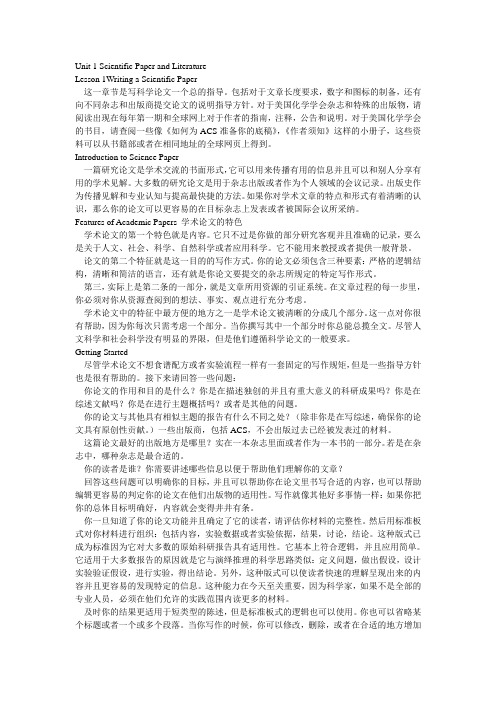
Unit 1 Scientific Paper and LiteratureLesson 1Writing a Scientific Paper这一章节是写科学论文一个总的指导。
包括对于文章长度要求,数字和图标的制备,还有向不同杂志和出版商提交论文的说明指导方针。
对于美国化学学会杂志和特殊的出版物,请阅读出现在每年第一期和全球网上对于作者的指南,注释,公告和说明。
对于美国化学学会的书目,请查阅一些像《如何为ACS准备你的底稿》,《作者须知》这样的小册子,这些资料可以从书籍部或者在相同地址的全球网页上得到。
Introduction to Science Paper一篇研究论文是学术交流的书面形式,它可以用来传播有用的信息并且可以和别人分享有用的学术见解。
大多数的研究论文是用于杂志出版或者作为个人领域的会议记录。
出版史作为传播见解和专业认知与提高最快捷的方法。
如果你对学术文章的特点和形式有着清晰的认识,那么你的论文可以更容易的在目标杂志上发表或者被国际会议所采纳。
Features of Academic Papers 学术论文的特色学术论文的第一个特色就是内容。
它只不过是你做的部分研究客观并且准确的记录,要么是关于人文、社会、科学、自然科学或者应用科学。
它不能用来教授或者提供一般背景。
论文的第二个特征就是这一目的的写作方式。
你的论文必须包含三种要素:严格的逻辑结构,清晰和简洁的语言,还有就是你论文要提交的杂志所规定的特定写作形式。
第三,实际上是第二条的一部分,就是文章所用资源的引证系统。
在文章过程的每一步里,你必须对你从资源查阅到的想法、事实、观点进行充分考虑。
学术论文中的特征中最方便的地方之一是学术论文被清晰的分成几个部分。
这一点对你很有帮助,因为你每次只需考虑一个部分。
当你撰写其中一个部分时你总能总揽全文。
尽管人文科学和社会科学没有明显的界限,但是他们遵循科学论文的一般要求。
Getting Started尽管学术论文不想食谱配方或者实验流程一样有一套固定的写作规矩,但是一些指导方针也是很有帮助的。
应用化学专业英语唐冬雁版1.1课文翻译

应用化学专业英语唐冬雁版1.1课文翻译第一篇:应用化学专业英语唐冬雁版 1.1 课文翻译1.11.1.1 What Is Chemistry About?The different kinds of matter that compose the universe are termed materials.Each material has its own distinguishing characteristics, which is termed its properties.These properties enable the material to be recognized or separated from other materials.(宇宙由不同种类的被称为材料的物质组成。
每种材料都有自己的显著特点,这称为它的属性。
这些特性使材料被认可或其它材料分开。
)The study of materials is the joint concern of chemistry and physics.Roughly stated, physics is concerned with the general properties and energy and with events which results in what are termed physical changes.Physical changes are those in which materials are not so thoroughly altered as to be converted into other materials distinct from those present at the beginning.(这项研究的材料是化学和物理学的共同关心。
粗略地说,物理学是关注的一般属性和能源,被称为物理变化导致的事件。
应用化学专业英语翻译(新版)
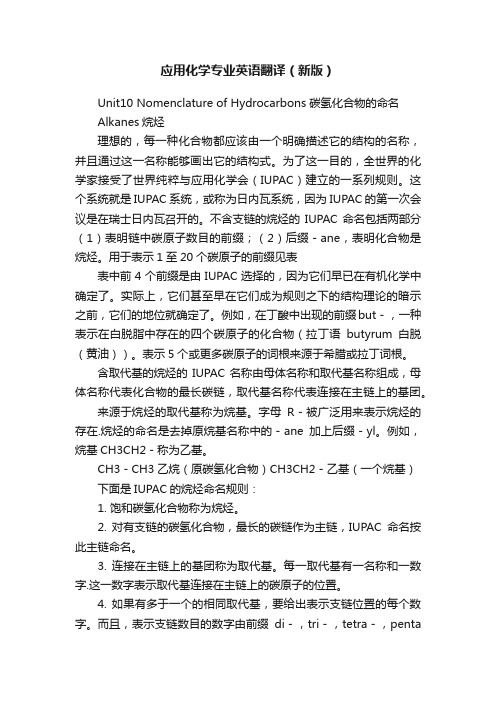
应用化学专业英语翻译(新版)Unit10 Nomenclature of Hydrocarbons碳氢化合物的命名Alkanes烷烃理想的,每一种化合物都应该由一个明确描述它的结构的名称,并且通过这一名称能够画出它的结构式。
为了这一目的,全世界的化学家接受了世界纯粹与应用化学会(IUPAC)建立的一系列规则。
这个系统就是IUPAC系统,或称为日内瓦系统,因为IUPAC的第一次会议是在瑞士日内瓦召开的。
不含支链的烷烃的IUPAC命名包括两部分(1)表明链中碳原子数目的前缀;(2)后缀-ane,表明化合物是烷烃。
用于表示1至20个碳原子的前缀见表表中前4个前缀是由IUPAC选择的,因为它们早已在有机化学中确定了。
实际上,它们甚至早在它们成为规则之下的结构理论的暗示之前,它们的地位就确定了。
例如,在丁酸中出现的前缀but-,一种表示在白脱脂中存在的四个碳原子的化合物(拉丁语butyrum白脱(黄油))。
表示5个或更多碳原子的词根来源于希腊或拉丁词根。
含取代基的烷烃的IUPAC名称由母体名称和取代基名称组成,母体名称代表化合物的最长碳链,取代基名称代表连接在主链上的基团。
来源于烷烃的取代基称为烷基。
字母R-被广泛用来表示烷烃的存在.烷烃的命名是去掉原烷基名称中的-ane加上后缀-yl。
例如,烷基CH3CH2-称为乙基。
CH3-CH3乙烷(原碳氢化合物)CH3CH2-乙基(一个烷基)下面是IUPAC的烷烃命名规则:1. 饱和碳氢化合物称为烷烃。
2. 对有支链的碳氢化合物,最长的碳链作为主链,IUPAC命名按此主链命名。
3. 连接在主链上的基团称为取代基。
每一取代基有一名称和一数字.这一数字表示取代基连接在主链上的碳原子的位置。
4. 如果有多于一个的相同取代基,要给出表示支链位置的每个数字。
而且,表示支链数目的数字由前缀di-,tri-,tetra-,penta-等表示。
5. 如果有一个取代基,主链碳原子编号从靠近支链的一端开始,使支链位号最小。
应用化学专业英语(课后答案和课文翻译)

Unit 1 The Rootsof Chemis tryI. Compre hensi on.1.It can be inferred from this articl e whichone of the followi ng itemsi s not mainly basedon practi c al use C. Greekchemis try2. It was B. Empedo cless who firsti ntrod ucedthe idea that all things are not formed from just one elemen t.3. In the develo pment of Greekchemis t ry, D. Democri tus was the first one defini tingthe ultimatelyconsti tuent s of matter?4. Accord i ng to Plato, thereare B. 4 ―elemen ts‖ whosefacesare consti tuted by regula r polygons.5. In the last paragraph,authors thinkthat experi ment DD.can deal with the reacti ons by whichone substa n ce is converted into anothe rII. Make a senten ce out of each item by rearra nging the wordsin bracke ts.1.The purifi catio n of an organi c compou nd is usuall y a matter of consid erabl e diffic ulty, and itis necess ary to employ variou s method s for this purpos e.2.Scienc e is an ever-increa singbody of accumu lated and system atize d knowle dge and is also anactivi ty by whichknowle dge is genera ted.3.Life, afterall, is only chemis try, in fact, a smallexampl e of chemis try observ ed on a si nglemundan e planet.4.People are made of molecul es; some of the molecul es in people are rather simple wherea sothers are highly comple x.5.Chemist ry is ever presen t in our livesfrom birthto deathbecause withou t chemis t ry therei sneithe r life nor death.6.Mathem atics appears to be almost as humanki nd and also permea tes all aspect s of humanlife,althou gh many of us are not fullyawareof this.III. Transl ation.1.(a)化学过程;(b)自然科学;(c)蒸馏技术(a) chemic al proces s (b) natura l science (c) the techni que of distil latio n2.正是原子构成铁、水、氧等。
应用化学专业英语朱红军第二版课文翻译
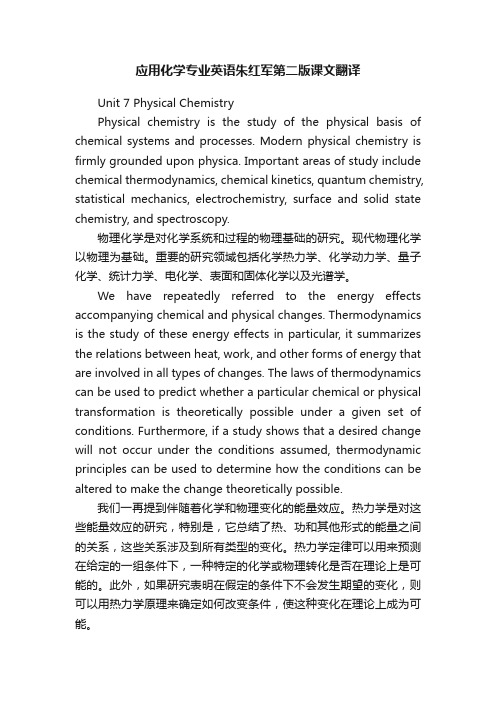
应用化学专业英语朱红军第二版课文翻译Unit 7 Physical ChemistryPhysical chemistry is the study of the physical basis of chemical systems and processes. Modern physical chemistry is firmly grounded upon physica. Important areas of study include chemical thermodynamics, chemical kinetics, quantum chemistry, statistical mechanics, electrochemistry, surface and solid state chemistry, and spectroscopy.物理化学是对化学系统和过程的物理基础的研究。
现代物理化学以物理为基础。
重要的研究领域包括化学热力学、化学动力学、量子化学、统计力学、电化学、表面和固体化学以及光谱学。
We have repeatedly referred to the energy effects accompanying chemical and physical changes. Thermodynamics is the study of these energy effects in particular, it summarizes the relations between heat, work, and other forms of energy that are involved in all types of changes. The laws of thermodynamics can be used to predict whether a particular chemical or physical transformation is theoretically possible under a given set of conditions. Furthermore, if a study shows that a desired change will not occur under the conditions assumed, thermodynamic principles can be used to determine how the conditions can be altered to make the change theoretically possible.我们一再提到伴随着化学和物理变化的能量效应。
(完整版)应用化学专业英语(课后答案和课文翻译)

Unit 1 The Roots of ChemistryI. Comprehension.1.It can be inferred from this article which one of the following items is not mainly based on practical use C. Greek chemistry2. It was B. Empedocless who first introduced the idea that all things are not formed from just one element.3. In the development of Greek chemistry, D. Democritus was the first one definiting the ultimately constituents of matter?4. According to Plato, there are B. 4 “elements” whose faces are constituted by regular polygons.5. In the last paragraph,authors think that experiment DD.can deal with the reactions by which one substance is converted into anotherII. Make a sentence out of each item by rearranging the words in brackets.1.The purification of an organic compound is usually a matter of considerable difficulty, and itis necessary to employ various methods for this purpose.2.Science is an ever-increasing body of accumulated and systematized knowledge and is also anactivity by which knowledge is generated.3.Life, after all, is only chemistry, in fact, a small example of chemistry observed on a singlemundane planet.4.People are made of molecules; some of the molecules in people are rather simple whereasothers are highly complex.5.Chemistry is ever present in our lives from birth to death because without chemistry there isneither life nor death.6.Mathematics appears to be almost as humankind and also permeates all aspects of human life,although many of us are not fully aware of this.III. Translation.1.(a)化学过程;(b)自然科学;(c)蒸馏技术(a) chemical process (b) natural science (c) the technique of distillation2.正是原子构成铁、水、氧等。
最新应用化学专业英语翻译

10级应用化学(2)班郑禄春 B2010063224Lessen 24 Chemical ReactionsConservation of mass and energy(质量与能量守恒)Two conservation laws(定律) apply to all chemical reactions: Energy can neither be created nor destroyed, and matter can neither be created nor destroyed. Thus the atoms taking part in a chemical reaction may be rearranged, but all the atoms present in the reactants must also be present in the products, and the total mass of the reactants must equal the total mass of the products.化学反应质量守恒和能量守恒两个守恒定律(定律)适用于所有的化学反应:能量既不能创造也不能消灭,物质也不能创造也不能消灭。
因此原子参与化学反应可能重新安排,但所有的原子出现在反应物必须包含在产品,反应物的总质量必须等于生产物的总质量。
What is a chemical reaction?A chemical reaction occurs when substances (the reactants) collide (碰撞) with enough energy to rearrange to form different compounds (the products). The change in energy that occurs when a reaction take place is described by thermodynamics(热力学)and the rate or speed at which a reaction occurs is described by kinetics (动力学) . Reactions in which the reactants and products coexist are considered to be in equilibrium(处于平衡). A chemical equation consists of the chemical formula (化学式)of the reactants, and the chemical formula of the products. The two are separated by an →usually read as “yields”and each chemical formula is separated from others by a plus sign (加号) . Sometimes a triangle is drawn over the arrow symbol to denote energy must be added to the substances for the reaction to begin. Each chemical formula may be preceded by a scalar (数量的) coefficient indicating the proportion (比例) of that substance necessary to produce the reaction in formula. For instance, the formula for the burning of methane(CH4 + 2O2 → CO2 + 2H2O) indicates that twice as much O2 as CH4 is needed, and when they react, twice as much H2O as CO2 will be produced. This is because during the reaction, each atom of carbon needs exactly two atoms of oxygen to combine with, to produce the CO2, and every two atoms of hydrogen need an atom of oxygen to combine with to produce the H2O. If the proportions of the reactants are not respected, when they are forced to react, either not all of the substance used will participate in the reaction, or the reaction that will take place will be different from the one noted in the equation..什么是化学反应一个化学反应发生在物质(反应物)碰撞有足够的能量去重新排列,形成不同的化合物(产品)。
- 1、下载文档前请自行甄别文档内容的完整性,平台不提供额外的编辑、内容补充、找答案等附加服务。
- 2、"仅部分预览"的文档,不可在线预览部分如存在完整性等问题,可反馈申请退款(可完整预览的文档不适用该条件!)。
- 3、如文档侵犯您的权益,请联系客服反馈,我们会尽快为您处理(人工客服工作时间:9:00-18:30)。
1.3 THE PERIODIC LAW周期律In 1869, Dmitri Ivanovitch Mendeleev (1834-1907) of Russia and Lothar Meyer (1830-1895) of Germany independently published their periodic arrangements of the elements. Both of these periodic arrangements were based on increasing atomic weights.译:1869年,俄罗斯的德米特里·伊万诺维奇门捷列夫(1834年至1907年)和德国的洛萨迈耶(1830至1895年)独立地出版了他们对元素的定期安排。
这两个周期的安排都是以原子量的增加为基础的。
At the time of Mendeleev's periodic table, about 63 elements were known. The brilliance and foresightedness of this work can be seen by the fact that Mendeleev left spaces between certain elements in his original table and predicted that these spaces would be filled by the discovery of new elements. He left a space for an undiscovered element after calcium and called the element eka-boron; another space was left under aluminum, which he called eka-aluminum; and another space under silicon, which he called eka-silicon. The term “eka” comes from Sanskrit meaning “one,” which Mendeleev used to indicate that the missing element was one place away in his table from the element indicated. Mendeleev even went so far as to predict, with high accuracy, the physical and chemical properties of those elements yet to be discovered. The three elements above were, in fact, discovered within his lifetime. Scandium (atomic number 21) was discovered in 1879 by Lars F. Nilson(1840-1899) of Sweden, and was found to correspond in properties to eka-boron; gallium (31) was discovered in 1875 by Lecoq de Baisbaudran (1832-1912),and was found to correspond to eka-aluminum; and ger-manium(32)was discovered in 1886 by C.A. Winkler (1838-1904),and was found to correspond to eka-silicon. The amazing way in which Mendeleev's predictions were fulfilled is illustrated in Table 1.2 which compares the predicted properties of eka-silicon with those of germanium.译:在门捷列夫的周期表中,大约有63种元素是众所周知的。
事实上,门捷列夫在他表中已确定的元素中留有空位并且预测这些空位会被以后发现的新元素填满,由此可见这项工作的辉煌和前瞻性。
他在钙的后面留了一个空位给未知元素并称之为准硼;在铝的下面留了一个空位并称之为准铝;在硅的下面留了一个空位并称之为准硅。
术语“准”来自梵文,意思是“之一”,是门捷列夫用来表示他表中指定元素中缺失的一个地方的元素。
门捷列夫甚至高精确度地预测了目前为止仍未被发现的元素的物理性质和化学性质。
事实上,上面提到的三个元素在他有生之年就已经被发现了。
钪(原子序号21)在1879年被瑞典的Lars F. Nilson(1840-1899)所发现,并证实它的属性符合硼;镓(31)在1875年被Lecoq de Baisbaudran (1832-1912)发现,并证实它的属性符合铝;锗(32)在1886年被C.A. Winkler (1838-1904)发现,并证实它的属性符合硅。
门捷列夫的预测以一种惊人的方式实现了,如表1.2,比较了准硅预测的那些性质和锗的性质。
Mendeleev constructed his table by arranging the elements in order of increasing atomic weights. The elements were tabulated so that those with similar chemical properties fitted into columns to form family groups. This arrangement left vacant spaces for undiscovered elements.译:门捷列夫通过以原子量增加的顺序来安排元素构建他的表。
那些化学性质相似的元素被制成列表,形成了族。
这样的安排给未被发现的元素留了空置空间。
Several modifications have been made to Mendeleev's table. First,a new family of elements, the noble gases, was discovered and added to the table. Also, it was observed that when the elements were listed according to increasing atomic weights, several discrepancies arose in the table. In the present table, for example, argon appears before potassium, even though the atomic weight of argon is greaterthan that of potassium. There is no mistaking that potassium should come after argon, because argon is certainly one of the noble gases and potassium behaves like the other alkali metals. There are two other places in the table where this type of deviation occurs.译:门捷列夫的表已经做了若干次修改。
首先,一个新的元素族,稀有气体,已经被发现并添加到表中。
其次,可观察到元素根据原子质量的增加被列出,一些差异呈现在表中。
在现在的元素表中,例如,氩出现在钾前面,尽管氩的原子质量比钾更大。
钾在氩的后面并没有错误,因为氩确实是稀有气体的一类并且钾的性质类似于其它碱金属。
在元素表中,还有其它两个地方也有类似的偏差。
The correct order of the elements was resolved by the British physicistH.G.J.Moseley(1887 -- 1915),who,while studying the X-ray emission frequencies of the elements, established that the elements should be arranged in order of increasing charge on their nuclei,namely,the atomic number.This correction nullified the above-mentioned discrepancies and led to the current statement of the Periodic Law.This law states that properties of the elements are periodic functionstheir atomic numbers . In this sense periodic means some regular cycle. With the discovery of isotopes for many the elements, it became more apparent that the atomic number is the correct basis for periodicity.英国物理学家.H.G.J.Moseley(1887 -- 1915)解决了元素的正确排列顺序的问题,当他研究元素的x射线发射频率时建立下面的理论:元素应该按照它们核电荷增加的顺序排列,也叫做原子序数,这种修正消除上述的矛盾,形成元素周期律现在的表示形式。
元素周期律声称,元素的周期性与原子序数有关。
这种意义上说,周期的意味着以一定的循环重现。
随着许多元素的同位素的发现,越来越彰显原子序数是周期性的正确基础。
As one studies the format of the periodic table,it becomes evident that the periodicity in the properties of the elements is due to therecurring similarities of their electron structures;当人们研究周期表的格式时,可以非常明显的看出元素性质的周期性是因为它们电子结构的相似s.在元素周期表中最常见的是长排. 在周期表中, 元素按照原子序数以一定的水平顺序排列. 结果形成7个水平周期. 除第一个外, 每个周期从碱金属开始, 以稀有气体结束. 这种排列, 形成纵行, 每个纵行具有相同或相似的外层电子结构, 因此具有相似的化学性质. 这些纵行被人们称为元素的族.The heavy zigzag line starting at boron and running diagonally down the table separates the elements into metals and nonmetals. The elements to the right of the line are nonmetals, and those to the left are metallic. The elements bordering the zigzag line are the metalloids and show both metallic and nonmetallic properties.With some exceptions,the characteristic electronic arrangement of metals is that their atoms have one, two or three electrons in their outer energy level, while nonmetals have five, six, and seven electrons in their outer energy level.从硼开始,沿着周期表对角走的Z型粗线将金属和非金属隔开,线的右边是非金属,线的左边是金属,靠近Z型线的元素是过渡金属,既具有金属也具有非金属的性质.除了一些特例,金属的特征电子结构是它们的最外电子层具有一个,两个或者三个电子,而非金属最外层则有五个,六个或者七个电子.It is interesting to note that with this periodic arrangement the elements fall into blocks according to the sublevel of electrons that are being filled in their atomic structure.The s block comprising groups ⅠA andⅡA have one or two s electrons in their outer energy level.The p block includes groups ⅢA toⅦA and the noble gases(except helium).in these elements electrons are filling the p sublevel orbitals. The d block includes the transition elements of groupsⅠB to ⅦB and group Ⅷ.The d sublevel of electrons are being filled in these elements.The f block of elements include the inner transition series. In the lanthanide series electrons are filling the 4 f sublevel.in the actinide series electrons are filling the 5 f sublevel有趣的是,这一周期性排列的元素分成区域,根据填充的亚层电子原子结构。
